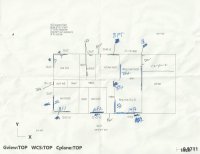A quick & dirty analysis of the heat loss of your foundation:
Looks like your house is about 30 x 48', but one of the 30' sides is mostly garage, so we'll ignore that for the time being. That means you have 48' + 48' + 30'= 126' of fully exposed foundation perimeter. Without measuring it, let's assume your exposure is really 2' average, not the 3'. That comes to 252 square feet of concrete exp
The R-value of 8" thick concrete wall is about R0.65, and adding in another R0.65 for the interior air film and R0.15 for the exterior air film you're looking at a best-case performance of about R1.5, or a U-factor of 0.67 BTU per hour per square foot per degree of temperature difference.
Let's also assume that when it's 5F outside the basement temp drops to about 50F. That's a 45F temperature difference. So the heat loss out of the exposed concrete is then at least:
252' x U0.67 x 45F=
7598 BTU/hr.
If the exposure really is 3' and not 2', the conducted heat loss is about
11,397 BTU/hr.
If the basement temp is warmer than 50F when it's +5F out, the loss is higher still.
So, what happens when you insulate the basement to code min? (= R15 continuous foam, or R5 foam + an R13 studwall). Instead of a U-factor of 0.67, the U-factor drops to 0.059. But the basment will probably idle along at 65F, not 50F, for a 60F temperature difference.
252' x U0.059 x 60F= 877 BTU/hr, if the exposure is only 2', a reduction of 6721 BTU/hr, which is 19% of the total heat load based on fuel use.
If it's 3' of exposure, and 378 square feet of exposure the loss is then"
378' x U0.059 x 60F= 1338 BTU/hr, a savings of 10,059 BTU/hr, which is 28% of your total heat load (and fuel use.)
And that's just the above grade portion. It also reduces losses to the cool soil as well.
You can't use just an R19 studwall approach without substantial risk of mold/rot inside the studwall. With 1.5-3" of rigid polyiso held to the concrete by furring through screwed the foundation with TapCons the mold risk is near zero, and you can mount 1/2" drywall (painted or not) as the code required thermal barrier against ignition. (This is what I did to my own home in Worcester, MA using reclaimed roofing polyiso, which is VERY cheap compared to virgin-stock goods.) If you want a fully finished basement with power & lights wired through the walls it's easier to go with 1" foil faced polyiso glued to the concrete with blobs of foam-board construction adhesive, and a 2x4 studwall with R13-R15 UNFACED (or kraft faced at worst, but definitely not foil faced) batts. Standard latex paint is a sufficient interior side vapor retarder against wintertime moisture accumulation, and the facers on the foam are adequate for rejecting ground moisture diffusion into the wall on the below grade section, but it needs to be able to dry toward the interior, which it can through 3-5 perm paint (standard interior latex.)
Since polyiso is somewhat hygroscopic, keep the cut edge off the slab by a half-inch or more, and keeping the bottom plate of the studwall off the slab is also important. An inch of EPS or XPS (but not polyiso) under the bottom plate that extends under the polyiso is a sufficient capillary break against ground moisture, and keeps the temperature of the bottom plate above the summertime dew point averages, keeping it dry & mold-free even during the dog-days of summer.
Reclaimed foam is cheap & effective for projects like this.
Searching the local craigslist for the terms
rigid insulation, will often find local sources. Worst-case, depending on where you are in CT it may be worth the drive up to
Green Insulation Group in Worcester, MA, or
Nationwide Foam in Framingham MA. Roofing foam usually starts at 2", and it's fine to go thicker than 1" with a studwall approach, but no thinner than 1" or you risk mold on the above-grade section of the studwall.
Before closing it all in, seal the top of the rigid foam to the foundation and foundation sill with can-foam. If you have to cut'n'cobble a bit of foam to make a continuous foam layer over the top of the foundation, foundation sill, and band joist that works too. You can then safely cut up some R15 rock wool batts to cover the band joist region for fire-safety and higher R.
Do a good job with the can-foam here- band joist & foundation sill leakage is usually the largest air leak in otherwise tight houses, adding up to more cross sectional area than all window & door crackage combined (!).
So, if you're planning to insulate the basement, when looking at heating source you should now be thinking of a heat load between 20-25,000 BTU/hr, not 35-40,000 BTU/hr, which affects your options by quite a bit, since that also lowers your water temperature requirements into the condensing zone. You may be better off with a tank type combi-heater like the smallest
HTP Versa, especially if you want to micro-zone it, since the thermal mass of the tank keeps it from short-cycling on zone calls.

